Menus
- Multistrada now with semi-active chassis
- The brakes – ABS optimized
- The "Skyhook"-landing gear
- The motor
- MOTORCYCLE points evaluation / conclusion
- Technical specifications
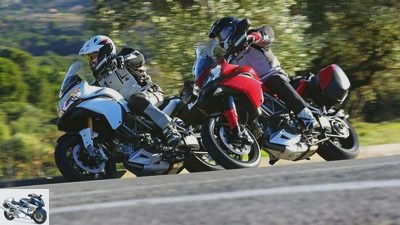
Jahn
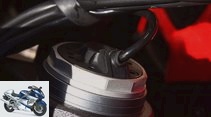
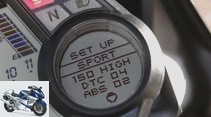
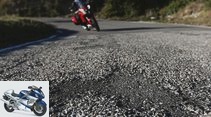
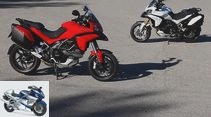
11 photos
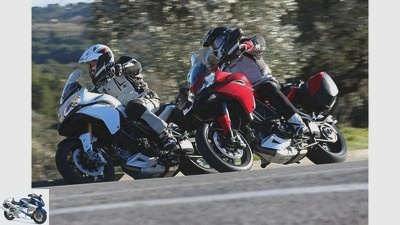
Jahn
1/11
Ducati Multistrada 1200 S old (model 2012 – white) versus new (model 2013 – red).

Jahn
2/11
…Adjusts the electronics via servomotors, the basic settings stored in the software, both on the front fork (damping)…
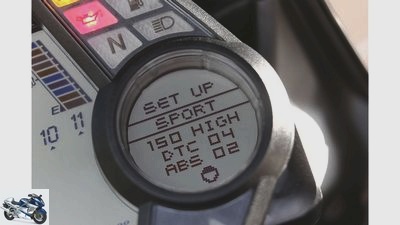
Jahn
3/11
A basic setup is assigned to each driving mode. In addition to top performance, traction control (DTC) and ABS sensitivity (ABS)…
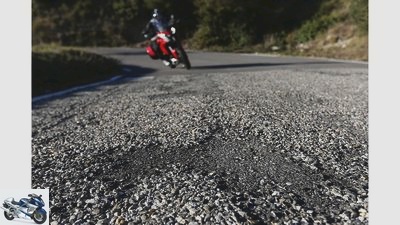
Jahn
4/11
The new "Skyhook"-High-tech suspension compensates for these unevenness with ease.
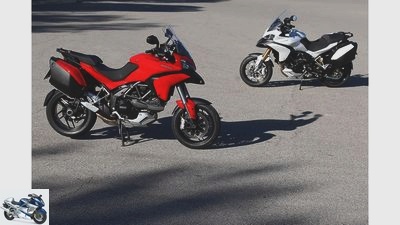
Jahn
5/11
Outwardly, the old (2012) and the new model differ only in minor details.
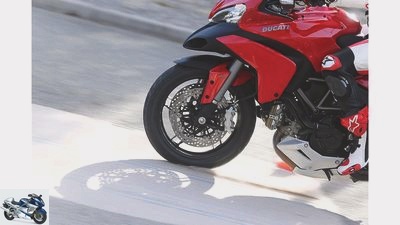
Jahn
6/11
Braking on sand with the ABS optimized stoppers.
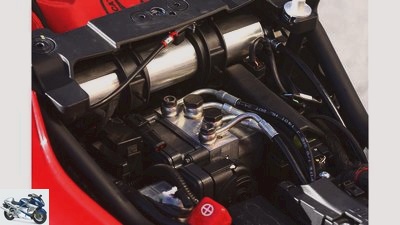
Jahn
7/11
Top: The latest control technology (Bosch 9 ME) improves the braking behavior enormously.
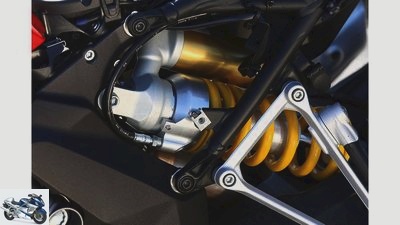
Jahn
8/11
…as well as on the shock absorber (damping and spring base). During the journey, sensors on the fork base and the fork bridge register…

Jahn
9/11
…on the swing arm (photo) and under the seat bench and adjust the damping dynamically via said servomotors.
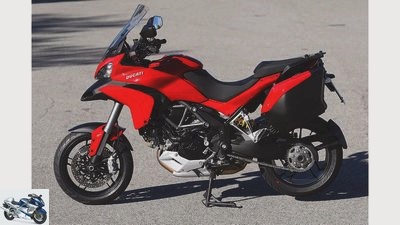
Jahn
10/11
Ducati Multistrada 1200 S, 2013 model.
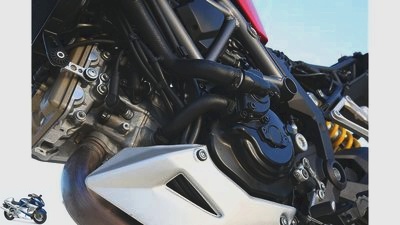
Jahn
11/11
The engine – double ignition: The second spark plug accelerates the combustion in the large individual displacement. The result: fewer pollutants and lower consumption.
Ducati Multistrada 1200 S Touring – old against new
Multistrada now with semi-active chassis
Skyhook is what Ducati calls the first semi-active chassis used in a travel enduro. Is the high-tech suspension really superior to the previous technology? And how do the engine and brake modifications affect??
D.ucatiii ”- the waiter in the“ Tourist Bar ”stretches the last syllable almost as long as he can breath. Wonderful how in French just the type of intonation is enough to turn a brand name into a proclamation of admiration. Even if the appreciation of the Garçon – one might guess – still comes from many Superbike World Championship titles and the charisma of stylish Supersport bikes, it is ultimately their fine nose for the model policy that the Italians have in the recent past parallel to the sporting one found the economic road to success. But as precisely as the reworked monsters, the brute muscle bike Diavel or the spectacular athlete Panigale met the taste of the Ducatisti in the past three years, for all of them it was only enough for the vice team behind the real chart striker from Bologna, the Multistrada. Since its debut in 2010, the travel enduro has been the bestseller in the Ducati model range in Germany.
Buy complete article
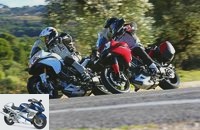
Ducati Multistrada 1200 S Touring – old against new
Multistrada now with semi-active chassis
Multistrada 1200 S Touring – a 2012 model, which accompanies the test as a reference, and the current 2013 version – in scene as usual. With their front-wheel-oriented tuning, they pull their radii fantastically safely like in a fairway milled into the asphalt, and with the engine that starts so powerfully at mid-rev, nip every hint of tranquility in the bud. And with it, without further ado, explain the Multistrada’s recipe for success: no one succeeds in the sweeping balancing act between a large travel-ready enduro and a supermoto sharpener better than the universal Italian.
Which with said “Skyhook” landing gear should now be even broader. The name hides the latest in chassis technology: an electronically controlled semi-active suspension. BMW drivers will immediately throw in the word ESA (Electronic Suspension Adjustment) at this keyword. Bavaria has been offering suspension tuning at the push of a button since 2005. However, when the button is pressed, the BMW technicians ultimately only replace screwdrivers and hook wrenches. Servomotors simply turn the damping valves and the hydraulically operating spring preload to the values specified in the driving modes. Sounds simple, but it works amazingly well.
Jahn
Outwardly, the old (2012) and the new model differ only in minor details.
Nevertheless, the idea of further refining this coordination is appealing. Wouldn’t it be great if the technology could recognize whether horse and rider are wagging up the bumpy pass on the last groove or enjoying the landscape on smoothly ironed asphalt while relaxing? And wouldn’t it be a dream if the chassis were then adjusted to the appropriate damping and suspension settings without being asked? This is exactly what the Multistrada’s semi-active suspension promises.
The wish is to be fulfilled by a working group: four acceleration sensors – two on the unsprung part (fork leg, swing arm) and two on the sprung part (fork bridge, rear frame) of the machine – supply information about the driving status (acceleration, deceleration) and the road conditions to a computer . The changes – according to the specifications of stored maps – the damping values on the fork and shock absorber. It only takes a hundredth of a second for the electronically controlled valves to cover the setting range between completely closed and completely open damping. Against this background, the developers can set up the software for the “Skyhook” landing gear on the existing Multistrada electronics platform. Each of the driving modes (Enduro, Urban, Touring, Sport) are now assigned the characteristics of the semi-active chassis in addition to the basic settings for engine and assistance systems. In addition to the basic setup, the limits of the corridor are also specified there, within which the damping should change in the respective driving modes.
Incidentally, this technology was baptized by fire at the end of last year in the high-end super sports car from BMW, the HP4 – with brilliant results in the MOTORRAD top test (issue 23/2012).
It’s good that with so much technical sophistication, even very mundane things can have a positive impact. For example the new windshield, which is 18 millimeters higher, 43 millimeters wider and can be moved further upwards. Shoulders, upper arms and – depending on your height – the helmet are almost completely in the slipstream. The fact that the shield can now be adjusted in height with one hand via a new central lock while driving is one of the small niceties with which the revised Duc creates a good mood.
Jahn
Ducati Multistrada 1200 S, 2013 model.
The same goes for the lighting, by the way, which with the combination of LED low beam and conventional high beam illuminates the road clearly brighter than the previous headlight combo and thus gradually gets a few counters in the MOTORRAD points evaluation. Which, after the basic design of the spring elements, which can still be optimized, they can definitely use. Because in the direct comparison, the new loses terrain in its supposed parade disciplines, of all things, the chassis tuning and the suspension comfort.
Yet: Regardless of all aspects of the new “Skyhook” technology, the more powerful ABS control, the fuel-saving double ignition, the brighter light and the better wind protection ultimately make the 2013 version a better Multistrada. Especially since the financial add-on for the model change remains moderate. At 18,790 euros plus 345 euros in additional costs, the new one costs exactly 300 euros more than its predecessor.
The brakes – ABS optimized
Jahn
Top: The latest control technology (Bosch 9 ME) improves the braking behavior enormously.
The Ducati electronics not only influence the engine and chassis settings in the various driving modes, but also the sensitivity of the ABS control in three stages. The touring and urban modes (both ABS level three), in which the new composite braking function in the Multistrada – the handbrake lever also acts on the rear brake – is practically the basic setup. Sport mode (ABS level two) makes the anti-lock braking system more aggressive and deactivates the compound braking function. In Enduro mode (ABS level one) the system tolerates even more slip and even allows the rear wheel to lock for a few seconds for braking drift on gravel.
On the two test tracks, the new Multistrada ultimately clearly undercut the deceleration values of the 2012 version in all modes. In the touring and urban mode intended for everyday use, the rear of the Ducati remains reliably on the ground even with maximum deceleration, the ABS reacts very sensitively on the sand fields, announces the control process only with a gentle pulsation in the hand lever – and brings the Multistrada up to 4 , 4 meters earlier to stand than its predecessor. A convincing idea.
The Duc creates an even shorter braking distance thanks to the very closely spaced sport and enduro settings. However, stoppies that cannot always be prevented (in sport and enduro mode) or even a front wheel that temporarily blocks in the sand (enduro mode) clearly assign these two ABS orientations to the more extreme purposes and experienced pilots already defined in their names.
Balance sheet
Well done. With the significantly improved braking behavior, the Multistrada impressively demonstrates the progress made in ABS technology. The measured values speak for themselves.
The "Skyhook"-landing gear
Jahn
Braking on sand with the ABS optimized stoppers.
With semi-active suspension elements, Ducati is entering technically demanding new territory. Because while the previous Multistrada S – in the style of the ESA from BMW – fixes damping and spring preload to various predetermined values via servomotors, the suspension in the “Skyhook” concept works dynamically. Four acceleration sensors analyze the current driving condition (acceleration, deceleration, bumpy or slippery road surface). A computer fed with this information then takes over the fine tuning of the damping on the fork and shock absorber via electric servomotors. Suspension on demand – a tempting idea.
In a direct comparison, the “Skyhook” model initially surprises with a noticeably tougher basic set-up. Even in the urban driving mode, which is comfortable by definition, the fully electrified Multi swallows edges or potholes, especially with the hindquarters, much less sensitively than its predecessor – even if it is rolling over the same terrain at the same time and at the same speed in the tight sport mode. The reason for this may certainly also lie in the spring of the strut, which is progressively wound after the first third of the spring travel (125 N / mm instead of 85 N / mm spring rate), this tight alignment is surprising, especially against the background of the extended influencing parameters of the “Skyhook” concept. All the more so because the chassis set-up of the 2012 Multistrada is already considered the sportiest, tightest of the entire touring enduro lineup. Even with the spring preload and damping reduced as an experiment using the submenu of Urban and Touring mode, comfort hardly improves. So there remains the determination of the position: The voting area of the new Multistrada begins where that of the 2012 Multistrada ends.
No effect without side effects. During braking maneuvers, the front dips much less deeply – be it due to a fundamentally tighter fork set-up or the electronic reworking in this situation – the new one remains on course with less stress. Just like in two-person operation. While the previous Multi tended towards a buckling rear when loaded, the 2013 edition is harmoniously balanced on the road thanks to its tight coordination and offers more reserves on top of that. Which is why the ride comfort with a passenger is much more pronounced than in solo use.
Which shows that the problem with the current multistrada is not of a conceptual nature. Because the possibilities offered by the new chassis electronics have only recently been demonstrated by BMW in the HP4 super sports car. With the technically comparable hardware (fork and shock absorber from Sachs, identical electronic damping adjustment), the Bavarians demonstrate what a huge balancing act in chassis tuning is possible. The fact that this technology is tailor-made for the wide range of uses of a travel enduro makes it of course extremely interesting for this segment. It’s all about ultimately using the potential through a successful basic set-up.
Balance sheet
The Multistrada does not take full advantage of the opportunities offered by modern chassis electronics. The basic set-up should be more comfortable for a travel enduro.
The motor
Jahn
The engine – double ignition: The second spark plug accelerates the combustion in the large individual displacement. The result: fewer pollutants and lower consumption.
One thing in advance: The lively engine of the Multistrada is undoubtedly one of the most emotional drives in the travel enduro segment. It is understandable that the technicians only carefully laid hands on the domesticated Supersport V2. Even if the second spark plug and a secondary air system in the 2013 propellant are mainly due to the pursuit of lower pollutant emissions, the measure is intended to provide six Newton meters more torque in the medium and more refined running smoothness in the lower speed range. But the test bench run already proves: the performance curves (see below) of the current and the previous model differ apart from the higher maximum speed (10600 rpm instead of 10200 rpm) of the revised engine only within the measurement tolerance. In practice, too, there is hardly any difference. The hope for a smoother concentricity below 3000 rpm also remains unfulfilled. The L-engine is still rumbling when it is strolling around, only accelerates a little more gently when the load changes in the 2013 configuration. However, the V2 rehabilitates itself in another respect. In a direct comparison, it consumed half a liter less than the previous model, both at motorway speed (6.2 liters) and on the country road (5.4 liters).
Balance sheet
More smoothness? More torque? Nothing. But with the lower consumption (0.5 liters), the engine update makes more friends than with a shot of more power.
MOTORCYCLE points evaluation / conclusion
Jahn
Ducati Multistrada 1200 S old (model 2012 – white) versus new (model 2013 – red).
| maximum number of points | Multistrada 2013 | Multistrada 2012 | Overall rating | 1000 | 692 | 686 |
| Price-performance note | 1.0 | 3.3 | 3.3 |
Conclusion
The new Multistrada can differentiate itself from its predecessor in many respects: the wind protection is more pronounced, the ABS controls more finely, its light shines brighter and it uses less fuel. But it is still astonishing that it cannot hold a candle to the conventional 2012 model with its most spectacular innovation, the semi-active suspension. The potential is there, but has yet to be tapped with a more comfortable basic set-up.
Technical specifications
Jahn
Braking on sand with the ABS optimized stoppers.
engine
Water-cooled two-cylinder four-stroke 90 degree V-engine, two overhead, toothed belt-driven camshafts, four valves per cylinder, desmodromic actuation, wet sump lubrication, injection, Ø 64 mm, regulated catalytic converter, 520 W alternator, 12 V / 12 Ah battery, Hydraulically operated multi-disc oil bath clutch (anti-hopping), six-speed gearbox, O-ring chain, secondary ratio 40:15.
Bore x stroke 106.0 x 67.9 mm
Cubic capacity 1198 cm³
Compression ratio 11.5: 1
rated capacity 108.8 kW (148 hp) at 9250 rpm
Max. Torque 125 [119] Nm at 7500 rpm
landing gear
Steel tubular frame, load-bearing motor, upside-down fork, Ø 48 mm, adjustable spring base, electronically adjustable rebound and compression damping, single-sided swing arm made of aluminum, central spring strut with lever system, electronically adjustable spring base, rebound and compression damping, double disc brake at the front, Ø 320 mm , Four-piston fixed calipers, rear disc brake, Ø 245 mm, two-piston fixed calipers, ABS, traction control.
Cast aluminum wheels 3.50 x 17; 6.00 x 17
Tires 120/70 ZR 17; 190/55 ZR 17
Tires in the Pirelli Scorpion Trail test
Dimensions + weights
Wheelbase 1530 mm, steering head angle 65.0 degrees, caster 110 mm, suspension travel f / h 170/170 mm, seat height * 840 mm, weight with a full tank * 245 [242] kg, payload * 185 [188] kg, tank capacity / reserve 20, 0 / 4.0 liters.
Two year guarantee
Mobility guarantee two years
Service intervals 12,000 km
Colors red, silver [red, silver, white]
Price 18 790 [18 490] euros
Additional costs around 345 euros
Performance
Top speed
245 km / h
acceleration
0-100 km / h 3.3 sec
0-140 km / h 5.2 sec
0-200 km / h 10.1 sec
Draft
60-100 km / h 4.1 sec
100-140 km / h 4.3 sec
140-180 km / h 4.9 sec
Speedometer deviation effective (display 50/100)
48/98 km / h
consumption
At 130 km / h 6.2 [6.7] l / 100 km
Country road
5.4 [5.9] l / 100 km
Theoretical range
370 [339] km
Fuel type
Super
Related articles
-
Top test: Ducati Multistrada 1200 S Touring
28 photos 1/28 In a total of four speed levels – Sport, Touring, Urban and Enduro – bits and bytes vary the chassis and engine…
-
Ducati Multistrada 1200 Enduro in the top test
www.factstudio.de 22 pictures www.factstudio.de 1/22 Ducati goes offroad. www.factstudio.de 2/22 E.g. 30 mm more ground clearance. www.factstudio.de 3/22 How …
-
Ducati Multistrada 1200 S in the top test
fact 30 pictures fact 1/30 Ducati Multistrada 1200 S. fact 2/30 A positive impression: The LED light is one of the best that the market currently has to offer ….
-
Comparison test: Ducati 1198 S against Ducati Multistrada 1200 S
Jahn Comparison test: Ducati 1198 S against Ducati Multistrada 1200 S Ducati 1198 S versus Ducati Multistrada 1200 S Content of One brand, one engine,…
-
Ducati Multistrada 1200 Enduro in the driving report
Ducati 25 pictures Ducati 1/25 Let’s first see what the Duc offers: thick comfort seat, large suitcase (special equipment), high windshield …
-
Ducati Multistrada 1200, Kawasaki Versys 1000 and Triumph Tiger 1050 in the test
Gargolov Funbikes in comparison test Ducati Multistrada 1200, Kawasaki Versys 1000 and Triumph Tiger 1050 With bag and pack on a big tour or simply …
-
Comparison test BMW R 1200 GS Adventure, Ducati Multistrada 1200 Enduro, KTM 1190 Adventure R.
Tanja O’Kelly 37 photos mio-fotografie.de 1/37 A different kind of comparison test with the large enduro bikes BMW R 1200 GS Adventure, Ducati…
-
Ducati Multistrada 1200 S in the driving report
Ducati 20 pictures Ducati 1/20 Ducati Multistrada 1200 S. Ducati 2/20 Ducati Multistrada 1200 S. Ducati 3/20 Ducati Multistrada 1200 S. Ducati 4/20 Ducati …
-
Ducati Multistrada 1200 Enduro Pro (2018) in the test
markus-jahn.com 16 pictures markus-jahn.com 1/16 How does the Ducati Multistrada 1200 Enduro Pro fare in the test? markus-jahn.com 2/16 Compared to …
-
BMW R 1200 R and Ducati Monster 1200 in a comparison test
Gargolov 30th photos Gargolov 1/30 Ducati Monster 1200 and BMW R 1200 R.. Gargolov 2/30 … modern headlights, … Gargolov 3/30 Ducati Monster 1200 and…